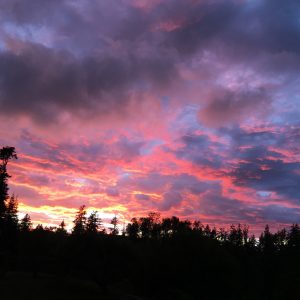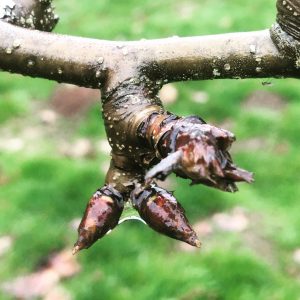In an ideal situation an apple tree would be trained and pruned the first year it is planted. Training helps develop good form and structure while the tree is young and the desired crotch angle of 45-65 degrees can be obtained by gently manipulating the branches by tying them to sandbags, using limb spreaders fashioned from toothpicks or wooden spreaders in lengths of six to eighteen inches. The development of watersprouts can be avoided by training branches to bend at a 45 to 65 degree angle which inhibits the flow of auxin. Annual training and pruning ensures a strong framework with the proper shape and form and structure that will help the tree live longer and make a higher quality of fruit, and make for less pruning as the tree matures. It is important to distinguish the difference between primary growth and secondary growth. Primary growth is an increase in the length of the shoots and is responsible for the trees height and width. Pruning primary growth enables you to control the height and width of the canopy. Secondary growth is the increase in thickness of the stems, stouter and stronger branches can support the weight of the tree’s fruit.
The first step is to have a clear plan, step back and notice the sun’s path and direction in relation to the tree. Recognize your reasons for pruning, aim to maximize fruit yield, open air space, and allow for light penetration. Before making your first cut it is vital to disinfect your pruners and shears with rubbing alcohol. The first decisions are clear, remove all dead or diseased wood and crossing branches. Next all suckers emerging from the base of the tree should be removed, as they are from the root stock and sap energy from fruit yield. Depending on the season, age, and health of the tree, removal of a large percentage of watersprouts should be considered since they take energy from the tree and only produce fruit when pulled or forced to bend. Watersprouts pruned in the winter make excellent scion wood for future grafting endeavors.
Before moving on to heading cuts and thinning cuts it’s best to keep in mind that only ten to thirty percent of tree should be removed while pruning. Thinning cuts remove the entire branch or twig, reasons for thinning are to maintain an open shape to allow maximum sun exposure and to control the growth of overly tall leaders, crossing branches, and limbs with narrow crotch angles. Heading cuts remove part of the tree’s branch to the terminal bud, stopping or slowing the flow of auxin while promoting growth and bud development. While pruning aim for an open bowl shape for optimal light penetration and air flow.
 I encountered this worm while pruning the liberty apple trees this week.
I encountered this worm while pruning the liberty apple trees this week.

 Sunset at Delphi
Sunset at Delphi



